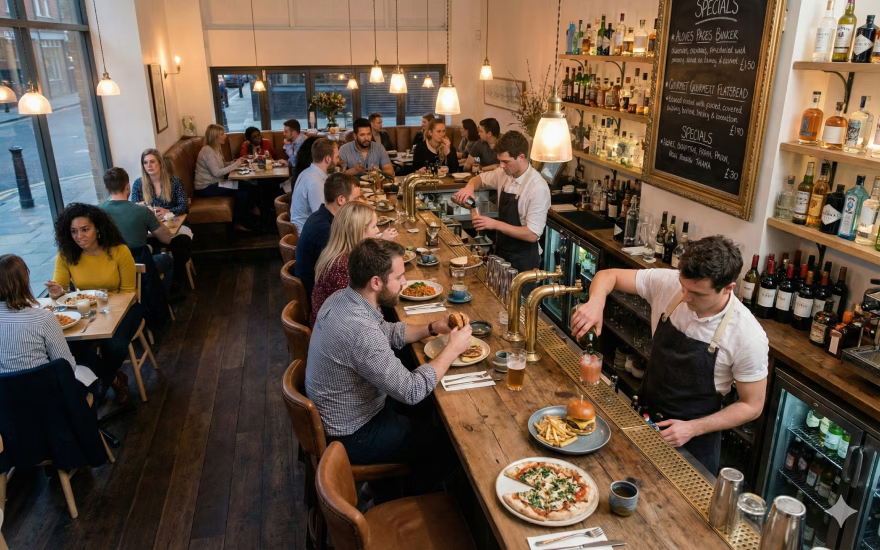6 Easy Ways To Drop Your Labor Costs Without Cutting Staff

If you work in the restaurant space, you know that labor costs make up the most significant piece of the pie when it comes to expenses — typically hitting around 30% of gross revenue. So what can you do to lower your restaurant labor costs without cutting down on your much-needed staff? In this article, we will review 6 great tips to cut back on costs while keeping your staff on the floor!
What are labor costs?
Labor costs refer to the expenses paid to staff during working hours. Labor costs are often compared against sales in a restaurant and then reported as a percentage.
"Good labor" means high sales with low labor, whereas bad labor would be the contrary.
Labor costs also represent the monetary value provided to staff, including but not limited to: hourly wages, salaries, overtime, payroll taxes, benefits, and so on.
Labor costs represent the monetary value provided to staff, including but not limited to: hourly wages, salaries, overtime, payroll taxes, benefits, and more.
What are some other restaurant operating costs?
Most commonly, you can break restaurant operating costs down into three buckets: Labor and people management, food costs, and rent/miscellaneous.
What goes into those buckets may vary depending on the type of restaurant you run or the kind of support you need to run a successful operation, but for the most part, those buckets will look like this:
Food costs
- Ingredients
- Wastage
- Theft
- Delivery Costs
- Menu Engineering
Labor and people management
- Hourly Labor Costs
- Salaries
- Payroll Software
- Workforce Management Software
- HR Software
- Bookkeeping and Accounting Costs
Rent and other costs
- Rent
- Utilities
- Maintenance and Repairs
How can I lower labor costs without cutting staff?
Sometimes cutting staff isn't the answer, especially if you have a busy restaurant where less staff might impact your ability to optimize food and liquor sales.
When this is the case, it pays to consider other ways that you can optimize your labor and increase your overall restaurant profits while you're at it!
.jpg)
1 - Consider more intelligent scheduling tools.
Consider reducing labor by using futuristic restaurant scheduling tools that pull real-time sales data and measure it against past labor to generate optimized schedules using machine learning! This magic tool is called schedule forecasting, and it's the future of restaurant scheduling. Using these software tools can help reduce labor costs by 3%!
2 - Stop paying for unworked hours.
In a recent study, a local juice bar discovered they were losing $91,200 per year paying employees for unworked hours. Why did this happen, and how can you overcome it?
An easy solution to combat time theft is using time tracking software. This tool alerts business owners when staff members punch into their shifts outside their allotted scheduled shift times and warns them. This allows business owners to stay on top of unpaid work hours, and when they add up that much - it's worth it!
3 - Hire more efficiently.
According to multiple sources, the average cost of hiring a new position is around $4,000, so using innovative technology, tools, and tips to streamline these operations can save you big money. If you haven't already, consider using an applicant tracking system to make hiring easy. You might also want to consider a platform that allows employees to self-onboard and other tools like interview templates and SOPs.
.jpg)
4 - Make automation your best friend.
Can you automate it? Then do! We live in the glorious age of technology, meaning many epic tools can help us run our business without lifting a finger.
If you manage a restaurant, consider using a software solution that offers automated tools such as streamlining worked hours to payroll, automating restaurant payroll calculations, or creating schedules based on week forecasts.
How does this help you cut down on labor? With this software, you could save up to 40 hours per week on admin tasks, because manual calculations are out, and payroll in one click is in.
5- Always consider the data.
The most shocking thing about data is that the results are often not what you would expect.
As a business owner who manages sales vs labor metrics, understanding and learning from the data could help you avoid losing money from being over or understaffed regularly. Lean into tools that offer integrations between your labor and sales so you can make choices that will make your business money.
Using the data and running restaurant reports will help you save on labor, but it will also help you optimize other aspects of your business, such as food and operations costs. Data is your new secret sauce.
.jpg)
6 - Hold onto the good ones.
It takes time to onboard, train, and refine your skills when working in the services industry. And the longer your staff stay, the more valuable they become. There is even a term for it, Human Capital Management. In other words, it pays to hold onto good people through best retention practices. So how can you pull it off?
There are many ways to keep great people, including hiring smart in the first place, having a great onboarding process, offering flexible working hours, listening to and appreciating your staff, and tracking employee performance. Great HR software can help you accomplish these goals.
Another way you might consider holding onto great staff is by implementing an Instant Pay or EWA (early wage access) program into your restaurant. The more incentive to stay and build their skills, the more efficient the worker. And the more efficient the worker, the lower your labor costs will be without having to cut staff!
That's all for now.
When it comes to significant ways to help lower your labor costs without cutting staff or sacrificing your restaurant's operations, these tricks should help you out.
If you are looking for an easy way to manage your people, book a free demo with us today.
Want to learn more ways you can increase your restaurant's profits? Check out our free guide with 20 hot tips here!



